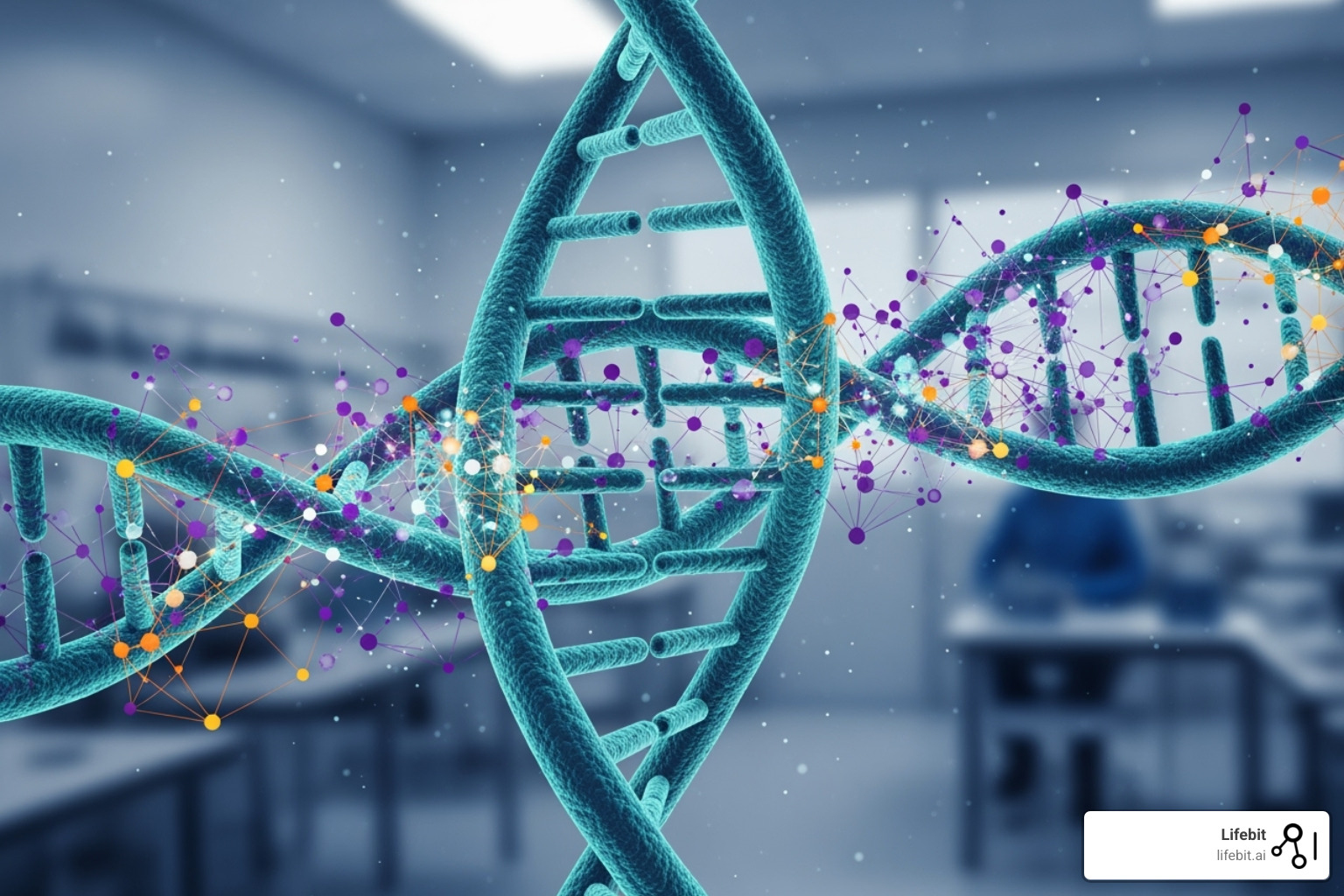Genomic Testing Explained (Without the Science Jargon!)

Why Genomic Testing is Revolutionizing Healthcare
Genomic testing decodes your complete DNA sequence, turning it into practical health advice. By looking at your whole genome—not just a handful of genes—clinicians can:
- Estimate your risk of common diseases (heart disease, diabetes, cancer)
- Predict how you will respond to specific medications (pharmacogenomics)
- Diagnose unexplained or rare disorders
- Match cancer patients to targeted therapies
- Identify inherited conditions before starting a family
A process that once took more than a decade now finishes in under 24 hours for less than £1,000. Because of this speed and affordability, roughly 42 % of people tested for cancer or rare disease receive actionable findings, and about half of them see their treatment plans change as a direct result.
Yet sequencing is only the first step. Interpreting millions of genetic variants while protecting patient privacy is complex. That’s where Lifebit comes in: our federated, cloud-based platform lets researchers analyse sensitive genomic data securely, without ever moving it outside its protected environment.
What is Genomics? (And How Is It Different from Genetics?)
Genomics studies the entire set of DNA instructions (about 3 billion letters) that make you who you are. Genetics, by contrast, usually focuses on one gene at a time. Think of genetics as reading a single recipe while genomics scans the whole cookbook.
Although our genomes are 99.9 % identical, the remaining 0.1 %—roughly three million differences— explains why caffeine keeps some people up all night or why only certain individuals get side-effects from a drug.
For an accessible primer, see A Brief Guide to Genomics.
Your Personal Instruction Manual
Your DNA is arranged into 23 pairs of chromosomes containing around 20,000 protein-coding genes plus vast regions of non-coding DNA that help regulate when those genes switch on or off. Tiny changes called single-nucleotide polymorphisms (SNPs) influence everything from eye colour to disease risk.
To put this in perspective, if you were to print out your entire genome using standard font, it would fill approximately 262,000 pages of text. Within this massive instruction manual, the protein-coding genes represent only about 2% of the total sequence. The remaining 98%, once dismissed as “junk DNA,” is now understood to play crucial regulatory roles, containing improvers, silencers, and other elements that control when and where genes are expressed.
The Scale of Genomic Variation
Those three million differences between individuals aren’t randomly distributed. Some regions of the genome are highly conserved—meaning they’ve remained virtually unchanged throughout human evolution because any alteration would be harmful or fatal. Other regions, particularly those not directly coding for proteins, show much more variation.
The most common type of variation is single-nucleotide polymorphisms (SNPs), occurring roughly once every 300-1,000 base pairs throughout the genome. While most SNPs have no effect on health, some can significantly impact how your body processes medications, responds to environmental factors, or develops diseases.
Beyond SNPs, humans also carry structural variants—larger changes like insertions, deletions, or rearrangements of DNA segments. These can range from a few base pairs to millions of base pairs in size. Copy number variants (CNVs), where individuals have different numbers of copies of particular DNA segments, account for more genetic variation between individuals than SNPs do.
Genetics vs. Genomics in Practice
• Genetics pinpoints single-gene disorders such as cystic fibrosis, Huntington’s disease, and sickle cell anemia. These conditions follow predictable inheritance patterns and can often be diagnosed with targeted testing of specific genes.
• Genomics tackles complex traits—heart disease, diabetes, depression, autism—where many genes and your environment interact. These polygenic conditions might involve hundreds or thousands of genetic variants, each contributing a small effect that combines with lifestyle and environmental factors.
For example, Type 2 diabetes involves variants in over 400 different genes, each contributing a small amount to overall risk. Environmental factors like diet, exercise, stress, and sleep patterns then interact with this genetic predisposition to determine whether someone actually develops the condition.
By analysing that wider network, clinicians can move from one-size-fits-all treatment to truly personalised care. This shift represents a fundamental change in medical practice, from reactive treatment of symptoms to proactive management based on individual risk profiles.
The Journey of a Genome: From Sample to Sequence

The Human Genome Project cost billions and took 13 years. Today an entire genome can be read overnight. The workflow is straightforward, but each step hides sophisticated biology and computing.
Five Key Steps
- Sample Collection – usually saliva or blood
- DNA Extraction – purify DNA from cells
- Library Preparation – chop DNA into fragments and add molecular tags
- Sequencing – next-generation machines read millions of fragments in parallel
- Data Analysis – software rebuilds the genome and flags variants
A single genome produces about 200 GB of raw data—enough to stream dozens of HD movies. Bioinformaticians then compare it to a reference genome to spot meaningful differences.
Technology Snapshot
- Sanger sequencing (1970s): ~80 bases per read.
- Next-Generation Sequencing (NGS): hundreds of thousands of reads simultaneously.
- Long-read platforms: >10 kb per read, useful for complex regions, though accuracy is still improving.
For a concise overview, read the CDC’s What is Genomic Sequencing?.
Keeping these data secure—especially when projects involve thousands of genomes—requires specialised infrastructure. Lifebit’s federated data analysis lets researchers run algorithms where the data live, eliminating risky transfers.
Real-World Applications of Genomic Information

Genomics has moved from lab benches to everyday decision-making in medicine, public health and agriculture, changing how we approach some of humanity’s greatest challenges.
Healthcare Revolution
Pharmacogenomics represents one of the most immediate applications of genomic medicine. Your genetic makeup determines how quickly you metabolize medications through variations in cytochrome P450 enzymes. For instance, approximately 7% of Caucasians are poor metabolizers of drugs processed by CYP2D6, meaning standard doses of medications like codeine, tramadol, or certain antidepressants could be ineffective or dangerous.
The FDA has approved pharmacogenomic information for over 200 medications, including warfarin (a blood thinner where genetic variants can affect dosing by up to 10-fold), clopidogrel (where 30% of patients carry variants making the drug less effective), and abacavir (an HIV medication that causes severe reactions in 5-8% of patients with specific genetic variants).
Rare Disease Diagnosis has been revolutionized by whole-genome sequencing. Before genomic testing, families often endured a “diagnostic odyssey” lasting 7-8 years on average, seeing multiple specialists and undergoing numerous tests. Today, whole-genome sequencing can identify a molecular diagnosis in up to 73% of patients with suspected genetic conditions, often within weeks rather than years.
The impact extends beyond diagnosis to treatment. For example, children with STXBP1-related disorders were previously managed only with seizure medications. Genomic diagnosis revealed that some patients respond dramatically to specific treatments like quinidine, changing their quality of life.
Cancer Genomics has ushered in the era of precision oncology. Tumor sequencing now guides treatment decisions for most cancer patients. Herceptin for HER2-positive breast cancer was one of the first targeted therapies, improving survival rates by 30-50% in appropriate patients while sparing others from unnecessary side effects.
Today, comprehensive tumor profiling can identify actionable mutations in 60-70% of patients, leading to treatment changes in approximately 40% of cases. The FDA has approved over 50 targeted cancer therapies based on specific genetic alterations rather than just tumor location.
Prenatal and Reproductive Health has been transformed by genomic technologies. Non-invasive prenatal testing (NIPT) analyzes fetal DNA circulating in maternal blood, detecting chromosomal abnormalities like Down syndrome with 99% accuracy and virtually eliminating the need for riskier invasive procedures in many cases.
Carrier screening now tests for hundreds of genetic conditions simultaneously. For example, 1 in 4 people of Ashkenazi Jewish descent carry mutations for genetic conditions like Tay-Sachs disease or Gaucher disease. Comprehensive carrier screening helps couples make informed reproductive decisions.
Polygenic Risk Scores represent the cutting edge of preventive medicine. By analyzing thousands of genetic variants simultaneously, these scores can identify individuals at high risk for common diseases years or decades before symptoms appear. For coronary artery disease, individuals in the top 5% of genetic risk have a 3-fold higher chance of heart attack, equivalent to having familial hypercholesterolemia.
Public Health Change
During COVID-19, pathogen genomics became a household term as scientists tracked viral evolution in real-time. Over 15 million SARS-CoV-2 genomes have been sequenced globally, enabling rapid identification of variants like Alpha, Delta, and Omicron. This genomic surveillance helped public health officials understand transmission patterns, vaccine effectiveness, and guided policy decisions.
The same approach now revolutionizes foodborne illness investigation. Traditional outbreak investigations took weeks; genomic fingerprinting can link cases within days. The CDC’s PulseNet system has prevented an estimated 270,000 illnesses annually by enabling faster identification and response to contaminated food sources.
Antimicrobial resistance monitoring uses genomics to track dangerous bacterial strains. Whole-genome sequencing can identify resistance genes within hours, compared to days for traditional culture methods. This speed is crucial when 700,000 people die annually from drug-resistant infections globally.
Beyond Human Health
Agricultural Genomics addresses food security challenges as the global population approaches 10 billion. Genomic selection in crops has accelerated breeding programs from 10-15 years to 3-5 years. Drought-tolerant maize varieties developed through genomic approaches now grow on millions of acres in Africa, improving yields by 20-30% during dry seasons.
Livestock genomics has transformed animal breeding. Genomic selection in dairy cattle has doubled the rate of genetic improvement, increasing milk production while reducing environmental impact per unit of milk produced.
Conservation genomics guides efforts to preserve endangered species. The California condor recovery program uses genomic data to maximize genetic diversity in breeding decisions, helping increase the population from 27 birds in 1987 to over 500 today.
For deeper reading, see Annex A: What is genomics? Definitions and applications.
The Expanding Universe of ‘Omics’ and Future Frontiers

Genomics opened the door to a family of system-wide approaches collectively called omics.
- Functional Genomics – links DNA sequences to their biological roles.
- Metagenomics – analyses entire microbial communities, such as your gut microbiome.
- Epigenomics – maps chemical tags that switch genes on or off in response to lifestyle or environment.
- Transcriptomics – profiles RNA, a real-time snapshot of which genes are active.
- Proteomics – studies the proteins that actually carry out cellular work.
What’s Next?
Global initiatives like the US All of Us program aim to sequence millions of participants from diverse backgrounds. Combining those data with electronic health records and AI/ML promises treatments tuned to each person’s biology, behaviour and environment.
Turning findies into approved drugs still takes 10–15 years, but secure data platforms—such as Lifebit’s Trusted Research Environment—are accelerating that pipeline by giving researchers instant, compliant access to multi-omic datasets.
Navigating the Ethical, Legal, and Social Landscape
Open uping a genome means handling the most personal data on Earth—not just about one individual but their relatives too. The ethical implications of genomic information extend far beyond traditional medical privacy concerns, touching on fundamental questions about identity, discrimination, and social justice.
Key Ethical Challenges
1. Data Privacy and the Myth of Anonymization
Unlike other medical data, genomic information can never be truly anonymized. Your genome is unique (except for identical twins), and even “de-identified” genetic data can often be re-identified through various techniques. Research has shown that 60-70% of individuals of European ancestry can be identified from genomic databases using only their genetic data and basic demographic information.
This creates unprecedented challenges for data sharing and research. Traditional approaches to medical privacy—removing names and addresses—are insufficient when the data itself is inherently identifying. The solution requires robust governance frameworks, secure computing environments, and careful consideration of consent processes.
2. Genetic Discrimination: Progress and Gaps
The Genetic Information Nondiscrimination Act (GINA) in the United States prohibits genetic discrimination in health insurance and employment, but significant gaps remain. GINA doesn’t cover life insurance, disability insurance, or long-term care insurance. Similar legislation exists in many countries, but enforcement and coverage vary widely.
Real-world discrimination cases continue to emerge. In 2019, a major life insurance company was found to have systematically denied coverage to individuals with BRCA1/BRCA2 mutations, despite the fact that many of these individuals had undergone preventive surgeries that dramatically reduced their cancer risk.
3. The Complexity of Informed Consent
Traditional medical consent assumes you know what you’re testing for and what you might find. Genomic testing turns this assumption upside down. A single test might reveal:
- Primary findings related to the original reason for testing
- Secondary findings unrelated to the original indication but medically actionable
- Incidental findings of uncertain significance
- Unexpected relationships (non-paternity, consanguinity)
- Predispositions to untreatable conditions
The American College of Medical Genetics recommends reporting 73 specific genes as secondary findings when identified during genomic sequencing, but patients can opt out. This creates complex counseling scenarios where genetic counselors must explain concepts like penetrance, expressivity, and variant classification to help patients make informed decisions.
4. Equity, Diversity, and the Reference Genome Problem
Most genomic research has historically focused on populations of European ancestry, creating a diversity crisis in genomics. As of 2019, 78% of participants in genome-wide association studies were of European ancestry, despite representing only 16% of the global population.
This bias has real clinical consequences. Genetic variants common in non-European populations are more likely to be classified as “variants of uncertain significance” simply because we lack sufficient data to interpret them. Polygenic risk scores developed in European populations often perform poorly in other ancestries, potentially exacerbating health disparities.
Initiatives like the All of Us Research Program, H3Africa, and the Human Heredity and Health in Africa (H3Africa) Initiative are working to address these disparities, but progress requires sustained investment and community engagement.
5. Incidental Findings and the Right Not to Know
Genomic testing often reveals information patients didn’t seek and might not want. Should laboratories report that a patient carries a mutation for Huntington’s disease when they were tested for cancer risk? What about variants that increase Alzheimer’s disease risk when no effective treatments exist?
Different healthcare systems have adopted varying approaches. Some offer tiered consent, allowing patients to specify which types of secondary findings they want to receive. Others provide comprehensive genetic counseling before testing to help patients understand the full scope of potential findings.
Emerging Ethical Frontiers
Pediatric Genomics raises unique challenges. Should parents have the right to test children for adult-onset conditions? How do we balance parental autonomy with children’s future autonomy? Professional guidelines generally recommend against testing children for adult-onset conditions unless medical management would begin in childhood.
Direct-to-Consumer Testing has democratized access to genetic information but raised new concerns about data privacy, result interpretation, and psychological impact. Companies like 23andMe and AncestryDNA have tested over 30 million people combined, creating massive databases that could be valuable for research but also present privacy risks.
Genomic Data Sharing across international borders creates jurisdictional challenges. The European Union’s GDPR treats genetic data as a special category requiring improved protection, while other jurisdictions have different requirements. Harmonizing these approaches while enabling beneficial research requires ongoing international cooperation.
Building Ethical Frameworks
Addressing these challenges requires multi-stakeholder collaboration involving:
- Patients and communities as partners in research design and governance
- Healthcare providers trained in genomic medicine and ethics
- Researchers committed to inclusive and responsible practices
- Policymakers developing adaptive regulatory frameworks
- Technology companies implementing privacy-by-design principles
Our federated model keeps data within its original jurisdiction, reducing re-identification risk while still enabling collaboration. By processing data where it lives rather than centralizing it, we can respect local privacy laws and cultural values while advancing global research goals.
The goal isn’t to eliminate all risks—that would also eliminate benefits. Instead, we must build systems that maximize benefits while minimizing harms, ensuring that the genomic revolution serves all of humanity equitably and ethically.
Frequently Asked Questions about Genomic Testing
Is genomic testing the same as a direct-to-consumer ancestry test?
Not quite. While both analyze your DNA, they differ significantly in scope and purpose. Direct-to-consumer ancestry tests typically look at hundreds of thousands of specific genetic variants (SNPs) to determine your ethnic background and find genetic relatives.
Genomic testing, particularly whole genome sequencing, examines all 3 billion letters of your genetic code and focuses on medically actionable information. It’s like the difference between reading a few selected pages of a book versus reading the entire encyclopedia.
Clinical genomic testing is performed in certified laboratories and interpreted by trained professionals, while consumer ancestry tests are designed for recreational use and aren’t intended for medical decision-making.
Can my genomic data predict my entire future?
Absolutely not, and this is a crucial distinction. Genomic testing reveals predispositions, not destinies. Your genes influence your health, but they don’t determine it entirely.
Most diseases result from complex interactions between multiple genes and environmental factors like diet, exercise, stress, and exposure to toxins. Even if you carry genetic variants that increase your risk for a condition, lifestyle factors can often significantly modify that risk.
For example, having genetic variants associated with increased heart disease risk doesn’t mean you’ll definitely develop heart disease. It means you might benefit from more careful monitoring and preventive measures like regular exercise, a healthy diet, and avoiding smoking.
Genomic testing is a tool for probability, not prophecy. It provides valuable information for making informed decisions about your health, but it’s not a crystal ball.
How accurate is genomic testing?
Modern genomic sequencing is remarkably accurate. The sequencing process itself achieves accuracy rates of 99.9% or higher, meaning fewer than 1 in 1,000 DNA letters are read incorrectly. The “finished” human genome sequence from 2007 had less than one error in 20,000 bases.
However, the challenge isn’t just in reading the DNA sequence accurately – it’s in interpreting what those sequences mean. This is where clinical scientists, geneticists, and bioinformaticians play crucial roles.
Third-generation sequencing technologies can have higher error rates (around 15%), but they’re rapidly improving and offer advantages like longer read lengths that can help resolve complex genomic regions.
The interpretation of genomic data requires expertise in genetics, medicine, and bioinformatics. That’s why clinical genomic testing involves multidisciplinary teams who filter, analyze, interpret, validate, and assess the data alongside patient health information before providing results.
Conclusion
Genomic testing represents one of the most significant advances in medicine since the findy of antibiotics. We’re witnessing a fundamental shift from reactive healthcare – where we treat diseases after they occur – to proactive and personalized healthcare that can predict, prevent, and precisely treat conditions based on your individual genetic profile.
The power of understanding our biological code extends far beyond individual health. It’s revolutionizing how we approach public health, develop new treatments, protect endangered species, improve crops, and understand life itself. When public health officials can track disease outbreaks in real-time using pathogen genomics, or when doctors can select the exact cancer treatment that will work for your specific tumor, we’re seeing the transformative potential of this technology.
Yet with great power comes great responsibility. The massive datasets generated by genomic research require sophisticated computational infrastructure, robust security measures, and careful attention to ethical considerations. The challenge isn’t just generating genomic data – it’s making sense of it in ways that benefit everyone while protecting individual privacy and rights.
This is where the rubber meets the road. Raw genomic data is just the beginning. The real magic happens when we can securely analyze this information across multiple institutions, combine it with other health data, and apply artificial intelligence to uncover patterns that would be impossible to detect otherwise.
At Lifebit, we’re addressing these challenges head-on with our federated AI platform that enables secure, real-time access to global biomedical and multi-omic data. Our Trusted Research Environment (TRE), Trusted Data Lakehouse (TDL), and R.E.A.L. (Real-time Evidence & Analytics Layer) components work together to deliver real-time insights, AI-driven safety surveillance, and secure collaboration across hybrid data ecosystems.
The future of genomics is bright, but it requires continued collaboration between scientists, healthcare providers, policymakers, and technology companies to ensure that the benefits of this field reach everyone who needs them.
Whether you’re a patient seeking answers about a rare disease, a researcher working to develop new treatments, or a public health official tracking disease outbreaks, genomic testing is becoming an indispensable tool in our collective effort to improve human health and understand the natural world.
The data analysis challenges are real, but so are the solutions. Every day, researchers around the world are using genomic insights to make breakthroughs that seemed impossible just a few years ago. The key is having the right tools and platforms to turn raw genetic information into actionable knowledge.
Ready to explore how genomic data can transform your research? Explore our platform for large-scale research and find how we’re making genomic insights accessible, secure, and actionable for organizations worldwide.

